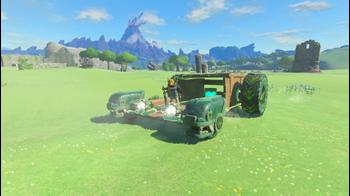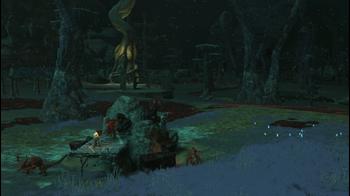
The Legend of Zelda: Tears of the Kingdom Review
With Breath of the Wild, Nintendo offered up a thoughtful reimagining of what a video game open world could be, and how it should feel to explore. It rocked the industry. The Legend of Zelda: Tears of the Kingdom has the unenviable task of following up on that feat, but it has a truly genius ace up its sleeve - and it’s all about recontextualizing what came before.
The biggest mistake that you can make going into Tears of the Kingdom is to assume that it is samey. Yes, the main world map of the game is the same Hyrule from BOTW, presented after a few years of redevelopment from the calamity before being beset with a new disaster: the upheaval. But the upheaval has brought huge change with it - including a smattering of small new ‘sky islands’, mysterious floating land masses that are remnants of an ancient past. Beneath Hyrule lurk ‘the depths’, a sprawling subterranean map that shocks with its scope. And Hyrule itself presents much new - from revitalized or newly-troubled towns to many more caves to go spelunking in.
While there’s a lot to be said about the all-new pieces of the world, Hyrule itself is actually one of the things that impresses me most. This is where the concept of recontextualisation soars. If you remember something from BOTW, I can practically guarantee you that Tears of the Kingdom has a pay-off in store for you. It might be a full side-quest, maybe a neat bit of dialogue, or perhaps a sweet environmental detail - but lip service is paid to the previous title and its world at every turn.
When at its best, Tears of the Kingdom blends that twisting of the familiar world with new ideas, mechanics, and zones. The way in which you enter the Lost Woods, for instance, is brilliant. The interplay between the three core areas - the sky, the surface, and underground - seeps into your mindset and locks itself there in a way only the most clever mechanics can. You’ll be gathering materials from one to fuel survival in the other, which feeds exploration of the next - and so on.
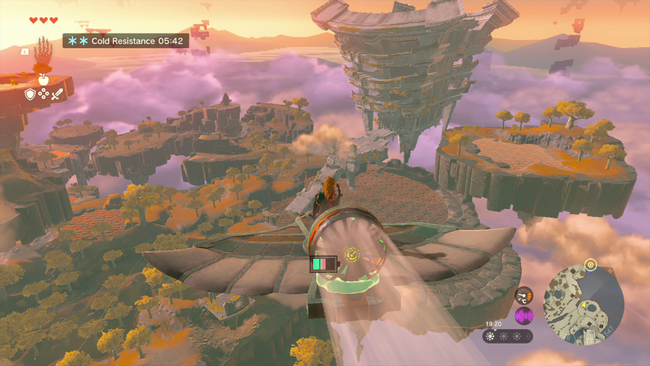
All of this is said from someone with the perspective of pushing a hundred hours - possibly more - in this game’s predecessor. But I also firmly believe this game will also hit well with newcomers. To the uninitiated, this will land in a very similar way to the original BOTW - as a more thoughtful, intricate, free-form open-world. But veterans would be foolish to think this is anything other than completely transformative; certainly the concept that something this significant could’ve been ‘DLC’ is utterly ludicrous.
This is a game with more breadth and depth on every level. Given readers of this site are more RPG-minded, a great place to demonstrate this is actually in the quest log. Tears of the Kingdom breaks this into four main sections: Main Quests, Side Adventures, Shrine Quests, and Side Quests.
Side Quests are busy-work; things that lead to treasures and gear, perhaps unique fights. They’re usually short and sweet, with minimal narrative thrust. Shrine quests are as they were in BOTW - short detours that each unlock and reveal a new shrine. But the Main Quests and Side Adventures are where the quiet revolution of Tears of the Kingdom is most profoundly felt.
Main Adventures now aren’t just the main dungeons - but instead point you down a number of alternate plot lines. Some of these will expand your knowledge of the narrative, while others will unlock new abilities for Link. All are meaty and significant. There are some returning concepts here - one ‘main’ mission that drops right at the top of the game and remains there until the credits roll, a quest for the Master Sword, and gathering memories to fill in missing plot details - but many more main quests differ from anything in the previous game. Surprisingly, it’s possible to get to the end of the game without unlocking all abilities, as several minor and one major skill are tied up in main quests you can simply ignore if you so choose.
Side Adventures, meanwhile, are the more hefty side quests. If you played BOTW, this is where multi-part storylines like building Tarrey Town now reside. They’re generally packed with narrative detail and carry more significant rewards. These things were few and far between in that game, but there’s a significant number of them here. These storylines make Hyrule feel far more alive than before.
The result is that progression feels more broad and multifaceted. There’s a lot more to do here beyond explore, tackle shrines, or advance the core dungeon storyline, and that’s the lifeblood that differentiates this game from its predecessor. It also immediately defines it, undoubtedly, as somehow more complete than a game that was pretty perfect to begin with. It also all feels a little bit more RPG.
As a Zelda game, its gimmicks and mechanics are of course as important as its world and quest design. The runes are replaced by four new powers - and here too the developers display a canny understanding of what was special but under-utilized in their last title.
Some have less utility than others, naturally. ‘Ascend’, which lets you quite literally ascend through solid objects - getting out of a cave by ascending through its ceiling back to the overworld, for instance - feels more like a classic Zelda skill that’d traditionally be bequeathed as a dungeon item. It’s well at home here, though, in a world redesigned into tiers - but I don’t expect to see too many mind-boggling uses for it.
The other three core powers feel more like they have more widespread utility. Recall lets you rewind individual objects in the world - so you can send a bomb or projectile tossed your way hurtling back towards an enemy, but also reverse the clockwork effect of some puzzle or another. This is one that frequently allows you to break out of the intended puzzle solutions, which is delightful.
Fuse is mostly used to power up weapons, and feels like both a concession to those frustrated with weapon degradation (which returns, but with dulled potency thanks to Fuse) and an acknowledgment that the system of elements, reactions, cause & effect in BOTW’s engine was underutilized. Not so here. The same appears to be the driving force behind Ultrahand, a crafting system that lets you mash things in the world together.
Ultrahand is your main tool for the entire adventure. This is basically a crafting skill that allows you to build things. At first, this is simple, gluing basic components together to make things like carts for your horse to draw. As you unlock more technological components, however, you can begin to create rudimentary machines. It’s brilliant.
Honestly, I don’t want to spoil too much here, so I’ll limit it to a couple of specific examples. One battle challenge shrine stripped me of my equipment but gave me enough components to basically build autonomous battle bots. I strapped spikes, flamethrowers, and lasers to robotic units that’d home in on enemy positions - and let the robots take the enemies on. Not only did this feel super rad - it introduced me to a core strategy I deployed multiple times in other fights.
Down in the depths, this new technology is key. Mechanized vehicles might not seem very Zelda, but the depths are pitch black and covered in ‘Gloom’, a deadly substance that saps your hearts when touched - not only hurting you, but also temporarily lowering your total maximum health. Navigating the dark depths is challenging - but it’s much easier in a vehicle that can transfer you over the gloom without touching it, complete with headlamps that pierce the darkness. You don’t have to do this, but this sort of experimentation of building is clearly what Nintendo anticipates.
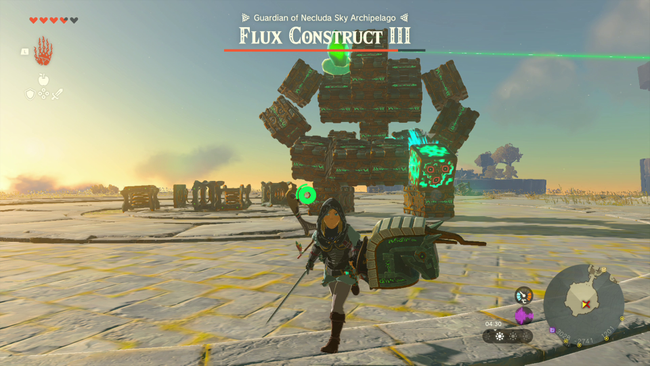
Ultrahand is also key in driving the interplay between the different layers of the world. You can carry materials for Ultrahand crafting in your inventory - but these resources are obtained through gachapon-style machines generally found in the sky. Each machine carries a slightly different stock of items, encouraging you to move around the skies.
If you’re not comfortable or confident building, or just find it uninteresting, you’re still covered. Following one of the main quest lines unlocks ‘Autobuild’, where you can build an expanding repertoire of developer schematics covering most scenarios in a single click. Autobuild can also be used to re-summon any of your own creations so long as you have the resources to hand.
And even if that isn't interesting to you, Ultrahand seeps into all manner of world exploration. I always carried a stock of spring parts, for instance, as I’d regularly use them stand-alone to give myself a boost, like a super jump. You can attach rockets to floating platforms or boxes and then clamber atop them to jet off. I also made a habit of combining springs with shields using Fuse - which creates a shield that bounces you skywards when you shield-surf. Another great version of that is to fuse a shield with a trolley or cart - which basically results in a skateboard.
I honestly can’t praise this mechanic enough. The only negative thing I can say about it, really, is that outlandish Ultrahand creations are most responsible for frame rate drops and performance issues. Even then, it feels a worthwhile trade-off in exchange for what this feature brings to the table.
Ultrahand and building in general is used in myriad genius ways - and it feels hugely more flexible than any individual puzzle mechanic in past Zelda titles. There’s one recurring mini-game, where you must use Ultrahand to help a hapless builder keep signs standing upright, that could form the backbone of an entire indie game. Here, it’s a random distraction you’ll find as you explore for minimal rewards. That about sums it up.
Old-school Zelda fans have all had one word on their lips in the run-up to release: Dungeons. And, well, here’s the rub: Tears of the Kingdom doesn’t really feature traditional dungeons. But what is on offer is closer to what some might be looking for, I feel, than what was in BOTW.
The main dungeons are structured a lot like the Divine Beasts - open-ended, with challenges you can tackle in more or less any order. However, they’re blessed with more elaborate lead-ins and introductions, some of which are truly awesome. Additionally, an AI companion joins you in each dungeon, each with a unique power that helps to unwind the Temple’s secrets. That carries a bit more of the feel of obtaining a new item in a dungeon and learning to use it via its puzzles.
Shrines are similar as ever - each equivalent to a room or two of a classic Zelda dungeon. But now there’s just generally more out on the maps. There are hundreds of caves and wells to go spelunking in. Sky islands feature puzzles that involve rotating whole floating worlds. And in the depths, there’s ancient mines, super-powerful enemies, and ultra-rare rewards. So there’s just more to do.
A serviceable narrative that is very similarly delivered to the last game strings all this together. I think taken out of context, it’ll feel identical to BOTW. That’s what I’ve seen expressed online as people foolishly immerse themselves in leaks. As a whole, though, I do think the story is more engaging. There’s an air of Zelda 2 - Adventure of Link here in that Link is a known quantity; here’s a hero, his antics in the last game known and celebrated. That leaves a significant textural ripple in your interactions as you travel the world. So too does the fact that this is generally a world that was in the early stages of a renaissance before disaster struck again. There’s a joy in seeing fledgling places from the previous game now blossomed into something new, even if they’re now beset with new problems.
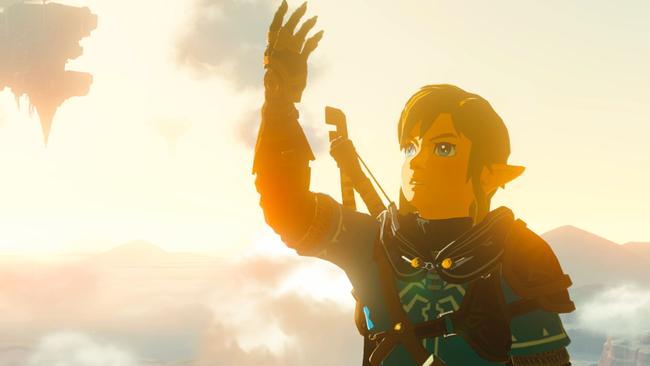
Which brings us back to what I said at the start - this is a game that aims to recontextualize and rebuild around the framework of one of the greatest games of all time. That’s a noble goal; nobler still is that it is successful.
Zelda has a history of happening upon magic and then sticking with it. Most every top-down Zelda lives in the shadow of A Link to the Past. The Ocarina of Time formula felt everlasting. You’d be forgiven for thinking Breath of the Wild would simply cast a shadow like those two games and inspire generations of iterations of its formula. From a distant and uninformed perspective, cynics might think this could’ve been DLC because ‘it’s the same map’ (it isn’t). But this is so much more. If we cast BOTW as a reboot, which it undoubtedly was, Tears of the Kingdom is absolutely the most significant and fresh-feeling Zelda sequel in decades - possibly ever.
It also presents us with a new all-time great duology. I can’t wait to replay Breath of the Wild, because after ninety-some hours with this game, I’m obsessed with the interplay between these two titles, and how knowledge of BOTW enhances Tears of the Kingdom. I can scarcely think of a video game sequel that so wonderfully rewards knowledge of its predecessor - it’s fantastic.
The mad lads actually did it. Tears of the Kingdom is actually better than its predecessor - something that seemed inexplicable to me even as I played it until, about six hours in, the weight of its quality became insurmountable. It’s one of the best games in years - and a masterclass in how to build a smart sequel.
